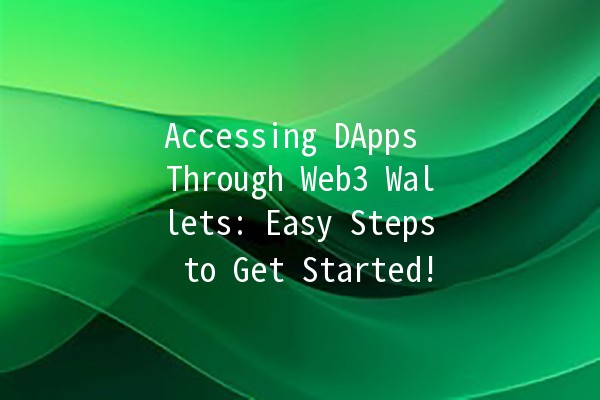
As the internet evolves towards a more decentralized model with Web3 technologies, users are discovering new ways to engage with decentralized applications (DApps). Utilizing a Web3 wallet is one of the integral components in this experience, allowing users to access a variety of services in a secure and efficient manner. In this article, we will explore practical tips for maximizing productivity while using Web3 wallets to access DApps and provide insights into utilizing these powerful tools effectively.
Understanding Web3 Wallets and DApps
What is a Web3 Wallet?
A Web3 wallet is a crucial software component that allows users to interact with the Ethereum blockchain and various DApps. Unlike traditional wallets, which hold physical currency and data, Web3 wallets manage users' private keys, enabling secure transactions and interactions within decentralized networks.
What are DApps?
DApps, or decentralized applications, leverage blockchain technology to operate without a central authority. They offer users various functionalities, from gaming and finance to social media and supply chain tracking. The synergy between Web3 wallets and DApps creates a unique ecosystem where users can engage confidently and privately.
Five Productivity Enhancement Tips for Accessing DApps via Web3 Wallets
Explanation:

Selecting the right wallet is fundamental. Different wallets come with various protocols, user interfaces, and features that cater to different needs.
Application Example:
For instance, MetaMask is a popular decentralized wallet that offers a userfriendly interface and browser extension, allowing seamless interaction with multiple DApps. On the other hand, hardware wallets like Ledger provide enhanced security for users who prioritize safety over convenience.
Explanation:
When connecting your Web3 wallet to a DApp, ensure you understand the permissions the application is requesting. This will help protect your data and assets from potential vulnerabilities.
Application Example:
For example, when you log into a new gaming DApp using your wallet, always verify which permissions the DApp is requesting. If a DApp asks for extensive access such as the ability to move funds from your wallet without your consent, it's vital to be cautious.
Explanation:
Many Web3 wallets come with builtin token swapping features that can save you time and transaction fees. This eliminates the need to leave your wallet interface to exchange tokens on external platforms.
Application Example:
For instance, if you're using a wallet like Trust Wallet, you can directly swap tokens within the app itself, facilitating easy conversion to the specific tokens you need to interact with a DApp without leaving your wallet.
Explanation:
Regular updates to your Web3 wallet ensure that you're equipped with the latest security features and improvements. Neglecting updates may expose your wallet to vulnerabilities.
Application Example:
Suppose your wallet provides a notification about a new version that includes an updated security feature. It’s crucial to install this upgrade immediately, as it may protect your assets from newly discovered vulnerabilities that malicious actors exploit.
Explanation:
With the rise of various blockchain networks, a multichain wallet allows you to access different DApps across multiple platforms without the hassle of maintaining various wallets.
Application Example:
Wallets that support multiple blockchain networks, such as Avalanche, Binance Smart Chain, and Ethereum, let you engage with various DApps simultaneously. For instance, you could navigate seamlessly between a DeFi DApp on Ethereum and a gaming DApp on Avalanche without switching wallets.
Frequently Asked Questions
There are primarily three types of Web3 wallets: hot wallets, cold wallets, and software wallets. Hot wallets operate online and are more convenient for daily transactions. Cold wallets, like Ledger or Trezor, store private keys offline, providing enhanced security. Software wallets, such as MetaMask, act as a bridge between a browser and blockchain, offering a userfriendly approach for accessing DApps.
To guarantee the security of your Web3 wallet, enable twofactor authentication, regularly update the wallet software, and never share your seed phrase with anyone. Use hardware wallets for storing substantial funds and inform yourself about phishing scams that trick users into revealing sensitive information.
Yes, most Web3 wallets offer crossdevice compatibility. You can access your wallet through browser extensions, mobile apps, or desktop applications as long as you have the right recovery phrase or private key. Ensure synchronization of your wallet across devices by logging in with the same credentials.
If you lose access to your Web3 wallet, you can retrieve it using your recovery phrase or seed phrase. It’s necessary to keep this information secured and backed up in a safe location. If you do not have the recovery phrase, unfortunately, it may not be possible to recover the wallet.
Yes, using DApps typically incurs transaction fees, usually referred to as “gas fees” on the Ethereum blockchain or similar fees on other networks. These fees are paid to miners or validators who ensure that transactions are processed and confirmed on the blockchain. Always check the fee structure on the platform you’re using.
To stay updated on the latest trends in DApps and Web3, follow relevant forums, social media channels, and news websites focused on blockchain technology. Participating in community discussions on platforms such as Discord, Telegram, or Reddit can also keep you informed about new developments and popular DApps to try.
Navigating the world of DApps through Web3 wallets can initially seem daunting, but with the right tools and knowledge, it becomes an empowering experience. By following these productivity enhancement tips, you can streamline your interactions with decentralized applications and maximize your enjoyment and efficiency within the Web3 ecosystem. Engage with the growing decentralized landscape confidently and securely, embracing the future of the internet.

